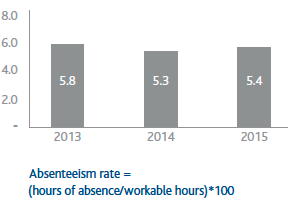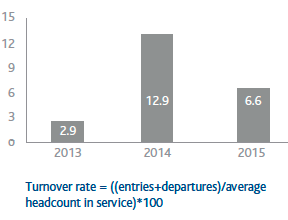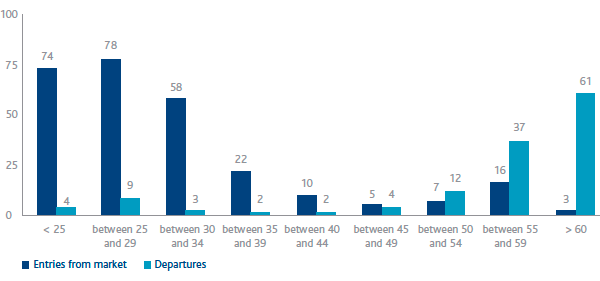Development of human, social and relationship, and intellectual capital

This section of the report deals with activities and initiatives that have an impact on aspects that do not relate directly to core business processes, but contribute to the creation of value for the Company and its stakeholders.
Job stability
To operate, Snam needs reliable employees with specialised expertise in managing technology, control systems, procedures and IT systems that are increasingly intricate and integrated.
In light of this, it creates value through the establishment and maintenance of stable, lasting working relationships. At 31 December 2015, out of a total of 6,303 employees, approximately 97% of Snam personnel have permanent employment contracts. The remaining 3% have apprenticeship contracts that, by law, are temporary (although historically, nearly all apprenticeship contracts have become permanent contracts at expiration, demonstrating the stability that Snam offers by providing lasting employment).
The average age of Group employees is 49, while the average length of employment is around 24 years, unchanged from the previous year. In 2015, 329 employees reached the landmark of 25 years’ service: 30 were employees of Snam, 97 of Snam Rete Gas, 160 of Italgas, 12 of Stogit, 1 of GNL Italia, 25 of Napoletanagas and 4 of AES.
| Download XLS (22 kB) |
|
2013 |
2014 |
2015 |
Permanent contract |
5,748 |
5,749 |
5,995 |
Apprenticeship or internship contract |
202 |
229 |
215 |
Fixed-term contract |
0 |
1 |
1 |
Part-time contract |
95 |
93 |
92 |
| Download XLS (22 kB) |
|
2013 |
2014 |
2015 |
Hired from the market (total) |
67 |
185 |
273 |
- of which university graduates |
46 |
75 |
105 |
- of which school graduates |
21 |
110 |
150 |
- of which women |
17 |
34 |
40 |
Other new employees (non-consolidated companies, tender acquisitions, etc.) |
16 |
213 |
109 |
ENTRIES FROM MARKET AND DEPARTURES IN 2015 BY AGE GROUP (NO.)
ABSENTEEISM RATE (%)

PERSONNEL TURNOVER (%)

Development of roles and skills
The system of developing employees’ professional and managerial skills plays a key role in creating value, since it allows human capital to evolve in harmony with changes in the context and the Company’s needs, particularly with a view to facing the new difficulties that are inherent in strategic projects to develop European networks.
In this sense, over time, Snam has developed its own repertoire of capacities and skills, as well as a set of indicators for evaluating potential. These tools, which are integrated into the performance evaluation process, allow the Company to support the development of its staff from the selection stage onwards.
In 2015, an additional step was completed with the implementation of the Snam Managerial Skills Model, which was developed in collaboration with Group managers. The model identifies the seven managerial skills deemed to be critical, describing them with reference in particular to activities that are specifically required due to the corporate context.
Launched in 2014, the performance management process has already involved some 1,000 people (including both evaluators and those being evaluated). All employees involved have access to a dedicated web space that provides all the operational and didactic tools they need to support them during the allocation, finalisation and feedback stages.
Professional enhancement
Training is another essential element for supporting the processes of organisational integration and change management, and for enriching the employment opportunities of Snam personnel.
In 2015, a total of 160,400 hours of training were provided (an average of 25.5 hours per employee), with 15,716 participants and a participation rate of 84.7%, testimony to Snam’s ongoing and wide-reaching commitment to updating and developing its employees’ expertise.
Special attention is paid to the oversight and transfer of technical and specialist skills, including within operational units, where it is essential to be able to rely on technicians and manual workers with expertise in maintenance and implementation activities. Specific training initiatives are designed for professional families and new hires.
With a view to opening up to international activities, Snam continued to offer advanced linguistic training via half-year courses, with individual lessons and study periods abroad, in which some 80 employees took part in 2015.
As regards training on the Code of Ethics, Model 231 and anti-corruption, a total of 3,025 hours of training were provided to 1,920 participants in 2015.
| Download XLS (22 kB) |
|
2013 |
2014 |
2015 |
Executives |
6,133 |
4,974 |
3,943 |
Managers |
23,699 |
14,509 |
18,814 |
Office workers |
117,942 |
73,404 |
86,010 |
Manual workers |
50,584 |
82,029 |
51,638 |
Total |
198,358 |
174,916 |
160,405 |
| Download XLS (22 kB) |
Description |
Hours provided |
Participants |
Recipients |
Managerial training: initiatives to support the new development systems (managerial skills), new courses for the improvement of critical soft skills, etc. |
4,768 |
639 |
Executives, managers and office workers |
Managerial training: |
2,990 |
284 |
Employees with high potential, experts, managers |
Managerial training: |
2,748 |
187 |
New graduates who joined the Group in 2015 |
Training dedicated to plant maintenance and knowledge of technical systems |
91,641 |
5,180 |
Technical and operational office and manual workers |
Foreign languages |
13,424 |
453 |
Executives, managers, office workers and technicians |
Evolution of corporate welfare
In 2015, it launched a project aimed at expanding its traditional welfare system, based on three development guidelines partly inspired by the results of employee research conducted in 2012: introduce new initiatives for emerging needs; draw up specific measures based on the needs of the Company’s various employees; and ensure that employees are aware, informed and involved.
One of the most significant outcomes in terms of perceived value has been the launch of the ‘smart working’ experiment. The experiment, which is currently limited to certain Snam departments, will be concluded in 2016 and, following analysis of the results, may be extended to all Group companies.
One of the most significant impacts of the corporate welfare ethos can be seen in the rising proportion of female employees, whose presence within the Company has historically been a small one, due partly to the nature of the work involved.
In 2015, 15% of new hires were women, whose proportion of the corporate population as a whole rose to 11.3%. Women account for 13.3% of managers and 7% of executives, with one of the three new executives appointed in 2015 being female.
Though in regulated sectors Snam has a natural monopoly, when dealing with its customers it adopts an approach based on a competitive market, in which it is essential to understand how the customer perceives value.
To that end, it carries out annual customer satisfaction surveys to gauge users’ level of satisfaction with regard to the clarity of the code, the availability and efficiency of IT services, and commercial management. These surveys are used to gather users’ suggestions for improving the services covered in the questionnaire.
The surveys conducted in 2015 involved 73 customers in the storage sector (with responses received from 68%) and 126 customers in the transportation sector (with a response rate of more than 83%). Assessments of the responses provided by customers indicate general satisfaction in both cases.
Relations with local communities
Snam is present, through its infrastructure, in almost all the country’s regions, in areas and communities that are varied in terms of culture, traditions and economic, social and environmental conditions.
The Company always seeks to ensure that its facilities are compatible with the environment, and the relations that link it to the local community are an asset that must be managed through a rigorous, transparent and collaborative approach.
To that end, the Company collaborates with local and national authorities to best illustrate its work execution plans to both the authorities and the affected communities. During the year, 129 meetings were held with local authorities and regional associations.
Total expenditure on donations, sponsorship and initiatives to benefit local communities, not including environmental compensation, amounted to around €753 thousand, in line with the figures from 2014.
Snam also carries out ‘shared value’ projects, which involve making its knowledge, expertise, unused space and assets available to local stakeholders (representatives from communities, regions and schools, suppliers, customers, etc.), testimony to the Company’s commitment to sharing its resources in order to better meet some of the communities’ needs.
Scope for generation of Shared Value |
Initiative |
Within the framework of supplier relationships, making corporate expertise available through a system of knowledge sharing, which will help companies in the supply chain in a process of continuous improvement that can increase both their own competitiveness and the dependability of their partnership with Snam, to the ultimate benefit of service quality. |
Quality and transparency in relations between the Company and suppliers. |
Grow together: the Suppliers Portal |
|
As part of Snam’s management and enhancement of sites and infrastructure, sharing space and knowledge with stakeholders in the area to encourage public acceptance of the legitimacy of the networks. |
Cultivating value: the social land in Terranuova Bracciolini |
Helicopter flyovers |
|
Tour of Italy in 80 bookshops |
|
The Italgas Historical Archive and Museum: a historic asset for the community. In 2015, the ‘M’illumino di libri’ project was born. This cultural project was created to make the Italgas Historical Archive and Museum in Turin increasingly present within the fabric of the city and more involved in the region’s cultural issues. The initiative comprises a series of events, meetings and performances centred on promoting books and reading, which will be held at the museum in the coming months. In this context, the Italgas Museum is also offering its spaces for a series of laboratories, workshops and events related to the ‘Booksound’ competition, a similar project aimed at promoting the reading of books out loud, promoted by the Renewable Literatures Association with help from LaAV (Letture ad Alta Voce, or Reading Out Loud) and aimed at junior and senior secondary school pupils. |
|
As part of the implementation of new investments, sharing with local communities and disseminating among local protagonists the knowledge of best business practices in the application of naturalistic engineering techniques in particularly delicate areas with complex ecosystems, such as parks and protected areas. |
Sustainable Paths – Parco della Majella – Parco del Ticino |
The value of communication
For Snam, proactive, balanced and transparent communication contributes to its relations with all its stakeholders, and has a direct impact on the visibility of its brand and the reputation of the Company. For this reason, over time it has developed a structured set of tools and channels, with a view to always offering high-value content, through both traditional methods and new media.
In 2015, Snam further refined its web identity by redesigning entire sections of its corporate website (www.snam.it) and seeking ever closer integration with all major social platforms on which it is present (Twitter, YouTube, LinkedIn, Google+, Flickr, Instagram, Slideshare, Facebook), in an attempt to reach an increasingly broad and more diverse audience. In order to achieve greater transparency, the “Ethics and Governance” section of the website, for example, was completely updated to include the topic of corporate ethics and how they are linked to governance and legislative compliance policies.
By way of recognition of the consistency and quality of its work, Snam retained third position in the KWD Webranking classification, which rewards those Italian companies that communicate most effectively online, and is compiled by independent specialist companies.
Throughout 2015, Snam was the subject of 275 articles in the national and international press.
The content and tone of these articles was judged positive or neutral in almost all cases (273), while the proportion of positive articles rose from 50% of the total in 2014 to 55%.
Innovation for business development
The Group’s strategic evolution in an increasingly complex and challenging context will require it to rely more heavily on developing innovation and on the good use of technological assets to ensure that it makes the most of what has already been achieved, as well as developing innovative solutions, as a support for and source of business development.
In this context, at the end of 2015, Snam began activities aimed at setting up a specific governance structure through the launch of ‘Project Innovate: Innovation Development & Technology Enhancement’. The project, which involves operational and business support departments, has the following objectives:
- Map the Group’s different technological, technical and constructive innovations carried out internally and with the support of external partners;
- Systematise the network of scientific collaborations with major research institutions and national and international universities;
- Carry out a market analysis to evaluate potential spaces for applying corporate expertise;
- Define and implement a network innovation model to promote the development of innovative ideas to boost assets for internal or market use.
During the course of the year, various research and development activities launched in previous years were either continued or completed. At the same time, some new projects were launched with a potential impact on various areas of corporate operations.
Gas metering
A campaign was carried out to test alternative gas quality metering tools to chromatographs, based on an experimentation protocol set out by the Polytechnic University of Milan. In the light of the positive results of the experiment, these tools will be introduced gradually on the transportation network as of 2016.
In gas distribution, we continued work on the technological innovation project relating to large-calibre ultrasound meters installed at the regulating and metering stations (REMIs). The readings from these meters were monitored and compared against those of traditional meters. We also continued to research innovative (ultrasonic and mass flow) and compact (with integrated remote reading and conversion system) meters.
In gas storage, following necessary trials, 2015 saw the installation of the first clamp-on ultrasonic natural gas metering system.
The Company continued its collaboration with the European Gas Research Group (www.gerg.info) and other European natural gas transporters and distributors, with reference in particular to the project for evaluating methods of estimating natural gas emissions, which was concluded by evaluating real gas leak measurements.
Governance and monitoring of the network and plants
The “Evolution of Remote Systems” project was launched, with the aim of ensuring the technological development of field apparatus for acquiring technical and process data and the methods through which they are connected and managed.
In gas storage, following a trial conducted on site, a project was launched to install phonometric systems to record any accidental leaks at plants and enable quick and effective blocking measures.
Physical integrity of pipes
The Company continued its collaboration with the research projects of the European Pipeline Research Group (www.eprg.net), together with major European operators in gas transportation and pipeline production, concerning:
- the experimental assessment of the resistance of curves created using cold bending;
- the study of a new model to assess the integrity of pipes subjected to mechanical damage;
- monitoring of the effects on underground pipes located in earth that presents instability of various kinds;
- preparation of criteria for the assessment of corrosion along the circumferential soldering;
- definition of test procedures to simulate the ageing of external facing and assess their resistance to the loss of adhesion.
In terms of distribution, with regard to anti-seismic measures taken to protect buildings, we continued work on the only project in Italy involving practical testing of a Japanese valve system that can intercept gas flows to important buildings in the event of seismic activity.ci.
Remote management of redelivery points
The Company continued to develop technological additions between workforce management systems and electronic meters, for both the launch of remote management of redelivery points and the optimisation of internal operating processes.
We also launched a new trial phase for point-to-multipoint radio technology, which will involve G4 electronic meters and radio concentrators, with the aim of generating the internal expertise needed to evaluate the benefits of its adoption, to supplement the current point-to-point meters.
Maintenance and checking of networks
The execution phase of the “Gas Transportation Network Asset Maintenance System” was launched, which is aimed specifically at completely overhauling work processes and regulations related to the transportation network, compression stations, storage, plants, metering and remote control. Specifically, during the year, the operators and technicians responsible for maintenance and metering activities were equipped with next-generation devices that use new maps and show real-time additional information about the surrounding environment (e.g. plant) using “augmented reality” technologies.
In terms of distribution, Italgas, due to the precise localisation and specific checking of pipe-laying conditions (layout, depth, etc.), makes use of the innovative equipment known as “georadar”, a radar device for underground surveying that allows users to scan large areas in a short space of time and to reveal, in a non-destructive, non-invasive way, the presence and position of underground objects using the reflection of electromagnetic waves.
Efficiency of plants
A study in partnership with the Polytechnic University of Milan was completed on the application of high-efficiency cogeneration systems in compression stations, with a view to reducing electricity costs and increasing the overall energy efficiency of the gas compression process. Based on the conclusions reached, two pilot plants have been identified where the execution phase can be carried out.
With regard to distribution, a project was launched with the aim of field testing a system for managing the heat produced by the thermal power stations attached to the REMIs. This system allows the optimisation of the gas pre-heating process, with a consequent reduction in costs due to self-consumption. The project aimed at optimising the quantity of odouriser injected into the network was also continued. Also in this sector, a project was launched to field test a system for the equipartition of the flow of gas provided by pressure reduction facilities, with the aim of evaluating their effectiveness in terms of reducing noise emissions, inter alia.
